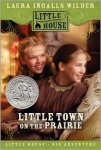
I grew up loving the Little House books, and when we lived in Minnesota, I didn’t realize how close we were to the prairies of South Dakota where Laura Ingalls Wilder settled. We took a weekend trip to the prairie in the western part of Minnesota when we lived there, near the South Dakota border, and the prairie was everything I’d hoped it’d be. We camped in summer at Blue Mounds state park in Minnesota.
The tall grasses were golden, as was the light at the end of the day, and the prairie rippled in wind like waves on the ocean. The land was flat, and we could see forever in that wide open space, where on the horizon grey-black clouds swept across the land full of fierce lightning. It was a wild and beautiful place, and I was eager to arrive in South Dakota on my reading tour so I could be a part of it again.
 Nonfiction book: Dakota: A Spiritual Geography
Nonfiction book: Dakota: A Spiritual Geography
Author: Kathleen Morris, born and raised in western South Dakota
Setting: modern farm near Lemmon, SD
Filled with essays on monastic life and its similarities to the ascetic quiet and harshness of western Dakota, this is a beautiful book about both living alone and living in a small community that depends on its members for survival.
It seems to me that especially in Western Dakota we live in tension between myth and truth. Are we cowboys are farmers? Are we fiercely independent frontier types or community builders?
The setting — the plains, the wind, the brutality of the weather — is as much a character in the book as the people, if not more so. It is always a delight to read prose by poets for that reason. The way Norris describes the simple act of hanging laundry — and that there would be such a thing as a good laundry day — captured almost everything about the place to me, especially as I remembered the beauty of hanging laundry in Minnesota: the sunshine on it, the way it swung in the breeze, and its fresh air scent, like the sheets and shirts and pillowcases had gathered the essence of outside for us to bring in.
I get started early, before six. It promises to be a good laundry day: a steady wind but not too strong… Hanging up wet clothes gives me time alone under the sky to think, to grieve, and gathering the clean clothes in, smelling the sunlight on them, is victory.
 Novel: Little Town on the Prairie
Novel: Little Town on the Prairie
Author: Laura Ingalls Wilder, settler in South Dakota
Setting: 1870s De Smet, SD
Laura Ingalls Wilder writes the beauty and wholesomeness of the pioneer life like no other. She leaves out the ugliness present in nearly every other pioneer or frontier book I’ve ever read. I appreciate that when I’m looking for light, pretty reading. As I age, though, it’s hard to ignore how whitewashed it is, and it’s disappointing to see the prejudices that exist even in Christian families like the Ingalls. It makes me sad to see how pervasive prejudice is, and I am weary with the struggle of constantly having to separate the art from the artist. Rather than go into all that, I’ll leave a pretty passage here that I loved.
The wind went by, and in the house the air stirred, pleasantly warmed by the cookstove and scented with prairie freshness and food and tea and a cleanness of soap and a faint lingering smell of the new boards that made the new bedrooms.
 Nonfiction book: The Soul of the Indian
Nonfiction book: The Soul of the Indian
Author: Charles Alexander Eastman, Sioux doctor appointed to a SD Indian Reservation
Setting: late 1800s Dakota Indian territory
Published in 1911 by a Native American chief, The Soul of the Indian is a first-hand account of the Dakota Indians’ social structure, religion, and some of their ceremonies. It was a bit of a dry read, but given the misconceptions of native tribes and their rituals at the time, I don’t think it was intended to be entertaining. Instead it was intended to observe, inform, and educate.
Given my disappointment in the Ingalls above, I appreciated reading some of Eastman’s wise observations about Christianity, civilization, and their own spirituality,.
Even in those white men who professed religion we found much inconsistency of conduct. They spoke of spiritual things while seeking only the material. The bought and sold everything: time, labor, personal independence, the love of women, and even the ministrations of their holy faith!
Whenever, in the course of the daily hunt, the red hunter comes upon a scene that is strikingly beautiful or sublime — a black thundercloud with the rainbow’s glowing arch above the mountain; a white waterfall in the heart of a green gorge; a vast prairie tinged with the blood red of sunset — he pauses for an instant in the attitude of worship. He sees no need for setting apart one day in seven as a holy day, since to him all days are God’s.